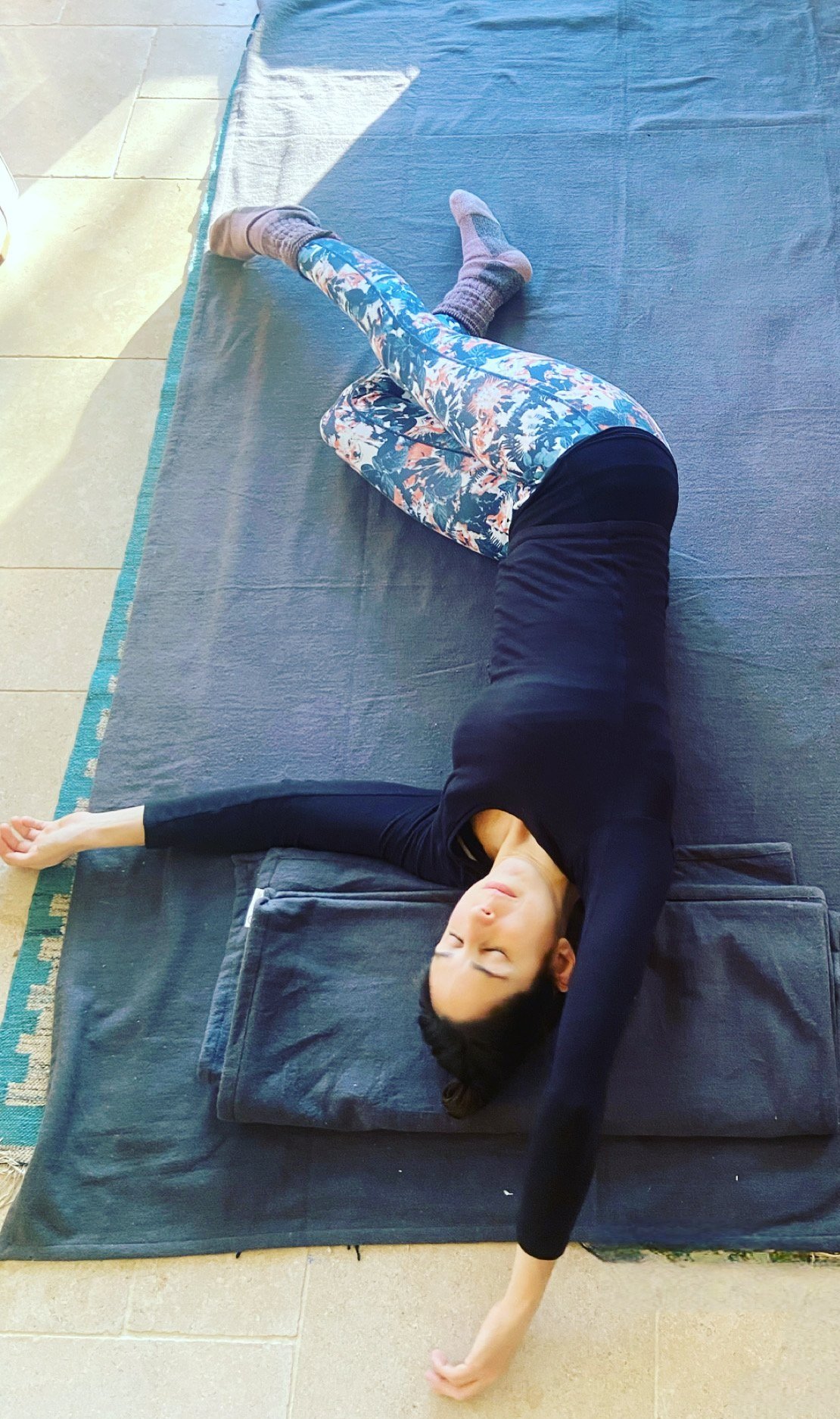
SOMATICS
I discovered Somatics in 2017 and it has played a major role in my own journey out of chronic pain. In 2023 I qualified as a certified Somatic Movement Educator with master teacher, Lisa Petersen (a long-time direct student of Donna Farhi, Bonnie Bainbridge Cohen and Amy Matthews). I offer one-to-one Somatics sessions from my garden studio in West Acre, Norfolk and group classes at Great Dunham Village Hall. My Yoga classes contain many elements of Somatics and increasingly I’m finding the distinction between Yoga and Somatics blurring in my own practice and teaching.
‘Soma’ is the ancient Greek word for the ‘living body’ (as distinct from simply ‘body’). We can think of the Soma as the body infused with consciousness or awareness. Thomas Hanna (founder of Hanna Somatics) defined it as ‘the body as perceived from within’.
What does ‘Soma’ mean?
Somatics is an umbrella term for any physical practice in which we get to know and understand ourselves from the inside out.
The branch of Somatics I work with most is Hanna Somatic Education, although I also draw on elements of the Feldenkrais method, Body-Mind Centering and Somatic Experiencing as well as ‘post-lineage’, enquiry-based approaches to Yoga such as that taught by Donna Farhi.
In a Somatic movement class, the teacher guides you, often through a series of questions, to sense and feel your direct, moment-to-moment first person internal experience. It is a practice based on curiosity and self-enquiry rather than striving to achieve something.
With practice, we develop sensitivity to ever more subtle experiences, ranging from physical to emotional and psychological. We start to appreciate that the body has a wisdom and a language of its own, which is often drowned out by the thinking, analytical mind. These practices hone our ability to truly listen to the language of the body, with compassion and open-mindedness.
What is Somatics?
Hanna Somatics is a gentle, therapeutic movement system devised by Thomas Hanna, PhD (1928-1990) in the 1970s, belonging to the same lineage as the Feldenkrais method and the Alexander Technique. At its most basic level, it is a toolkit of very slow, focused and conscious exercises designed to release chronic patterns of muscular and fascial tension (which is often unconsciously held) and to help us recover and maintain easeful movement for the duration of our lives.
The exercises, which are mostly floor-based, and practiced very slowly and consciously, calming the nervous system and helping to cultivate moment to moment awareness of our sensory experience. In this way, we gain insight into the root causes of our tension and pain, which can be both physical and emotional/ psychological in nature. Instead of relying on an external therapist to ‘fix’ our issues, Somatic movement teaches us to sense and feel what is happening inside our bodies so that we are empowered to make changes to our patterns from the inside out.
Most people report finding the practice profoundly soothing and grounding, rather like a deep internal self-massage
HANNA SOMATICS
SENSORY MOTOR AMNESIA
Thomas Hanna developed the concept of Sensory Motor Amnesia. SMA occurs when our muscles become so tense that they never relax. They become stuck in a state of chronic, habitual and involuntary tension due to repetitive patterns of use (think of sitting hunched over a computer for hours every day or always carrying a bag on the same shoulder) but also due to life stresses, such as injuries, surgery, illness and emotional stress and trauma. Over time the brain loses sensation of the affected muscles and actually ‘forgets’ how to release them.
The Somatic exercises teach the nervous system how to release this chronic muscular tension and to move, sit, stand, walk and lie with ease and efficiency in our daily lives. They are practiced very slowly and consciously so that the brain and nervous system are actively engaged in the learning process. Most of the exercises involve a specific technique called Pandiculation.
Have you ever watched a cat or a dog get up from its bed, stretch out its front legs and arch its back, often accompanied by a yawn? This is what Thomas Hanna termed a pandiculation (from the Latin pandiculare: ‘to stretch oneself’). Think of it as a full body yawn and stretch, but unlike passive stretching a slight amount of tension is retained in the muscles even as they lengthen. We often do this instinctively ourselves first thing in the morning. In fact all vertebrate animals tend to reflexively pandiculate in this way when transitioning from sedentary to active because it wakes up the sensory cortex, the part of the brain involved in co-ordinating movement. It is our innate response to lack of movement and the accompanying build-up of tension in our muscles.
Most of the somatic exercises engage a form of voluntary and targeted pandiculation. There are 3 stages to the movements:
Rather than ‘stretching’ a tight group of muscles, we voluntary tighten the muscles even more than they already are.
Then we very slowly release the contraction, engaging the brain in the process (in order to rewire the ‘amnesic’ muscles.)
We completely relax the muscles (sometimes referred to as the ‘moment of melt’)
PANDICULATION
find out more
No amount of theory can convey how profound Somatics can feel. To really understand it, and to appreciate the depth of insight it can give you into yourself and the way you inhabit the world, you need to try it.
Please get in touch if you’d like to book a one-to-one session or check out the class offerings page for upcoming group Somatics classes.
further reading:
Thomas Hanna, Somatics, reawakening the mind’s control of movement, flexibility and health (Lifelong Books, 1988)
Martha Peterson, Move Without Pain (Sterling, 2011)


